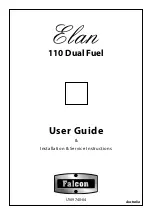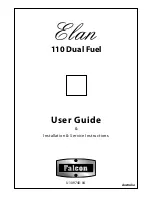
6
c) Minimum regulation of the hob burners:
•
Turn the tap to minimum;
•
Remove the knob and adjust the regulation screw,
which is positioned in or next to the tap pin, until the
flame is small but steady.
NB.: In the case of liquid gas, the regulation screw
must be screwed in all the way.
•
Check that the flame does not go out when you turn
the tap quickly from high to low.
d) Regulating the primary air of the burners: the primary
air of the burners does not need to be regulated.
Burner and Nozzle Specifications
Table 1
Liquid Gas
Natural Gas
Burner
Diameter
(mm)
Thermal Power
kW (p.c.s.*)
By-Pass
1/100
Nozzle
1/100
Flow*
g/h
Nozzle
1/100
Flow*
l/h
Nozzle
1/100
Flow*
l/h
Nominal Reduced
(mm)
(mm)
***
**
(mm)
(mm)
Fast
(Large)(R)
100
3.00
0.7
41
86
218
214
116
286
143
286
Semi Fast
(Medium)(S)
75
1.90
0.4
30
70
138
136
106
181
118
181
Auxiliary
(Small)(A)
55
1.00
0.4
30
50
73
71
79
95
80
95
Supply
Pressures
Nominal (mbar)
Minimum (mbar)
Maximum (mbar)
28-30
20
35
37
25
45
20
17
25
13
6,5
18
*
At 15°C and 1013 mbar- dry gas
**
Propane
P.C.S. = 50,37 MJ/Kg
***
Butane
P.C.S. = 49,47 MJ/Kg
Natural
P.C.S. = 37,78 MJ/m
3
S
R
A
ø 180
K6M52/EO
Important
On completion of this operation, replace the old rating
sticker with one indicating the new type of gas used. This
sticker is available from our Service Centres.
Note
Should the pressure of the gas used be different (or vary)
from the recommended pressure, it is necessary to fit a
suitable pressure regulator onto the inlet pipe in compli-
ance with current standards regarding “regulators for chan-
nelled gas.”.







































